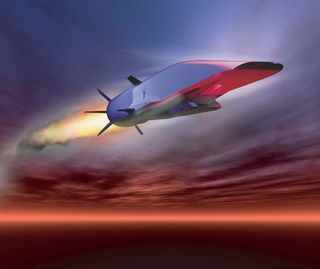US Military's Hypersonic Jet Could Fly 5 Times the Speed of Sound

The U.S. military is reportedly developing a hypersonic jet plane that could soar at up to five times the speed of sound — faster than a bullet, which generally travels at Mach 2, or twice the speed of sound.
The new hypersonic vehicle, which could take flight by 2023, builds upon research from a 2013 test flight of an experimental hypersonic vehicle, the X-51A Waverider, according to Military.com.
The $300 million X-51A program began in 2004. The program's final test flight occurred May 1, 2013, when the unmanned Waverider reached a top speed of Mach 5.1 (more than five times the speed of sound) in just over six minutes, before it was intentionally crashed into the Pacific Ocean. At the time, U.S. Air Force officials said the flight was the longest-ever for a hypersonic vehicle of its kind. [Flying Saucers to Mind Control: 7 Declassified Military & CIA Secrets]
During the 2013 test flight, the hypersonic jet was released from a B-52H Stratofortress at an altitude of 50,000 feet (15,000 meters). After separation, the Waverider accelerated to Mach 4.8 in just 26 seconds, powered by a solid rocket booster. The hypersonic jet separated from the rocket at an altitude of 60,000 feet (18,300 m), eventually reaching Mach 5.1 with its air-breathing supersonic combustion ramjet (or scramjet) engine.
"X-51 was really a proof of concept test. It showed that you could get a scram jet engine, launch it off an aircraft and it could go hypersonic," Mica Endsley, the Air Force's chief scientist, told Military.com. "It was able to go more than Mach 5 until it ran out of fuel. It was a very successful test of an airborne hypersonic weapons system."
But the military's next-generation hypersonic vehicle will go even further, Endsley said. This time, engineers in the Air Force and the Defense Advanced Research Project Agency (DARPA) will take into account materials that can work well at hypersonic speeds and guidance systems that are smart enough to point the plane in the right direction quickly, she added.
DARPA is working on multiple projects to study the capabilities of hypersonic flight. Several years ago, the agency conducted hypersonic test flights with an HTV-2 bomber; in 2011, the bomber prototype reached a top speed of Mach 20 before losing control. The Air Force has also said it is working on hypersonic weapons that could be fired from aircraft traveling at high speeds.
Sign up for the Live Science daily newsletter now
Get the world’s most fascinating discoveries delivered straight to your inbox.
Additionally, in 2014, DARPA announced it would continue with its Experimental Spaceplane (XS-1) program, an initiative to develop a military space plane to launch small satellites into orbit. Boeing, Masten Space Systems and Northrop Grumman were all awarded funding for the project, which DARPA officials said could provide a foundation for future fleets of hypersonic vehicles.
Follow Live Science @livescience, Facebook & Google+. Original article on Live Science.

Most Popular


